Indigenous Sustainabilities: Decolonization, Education, and Collaboration at the Ojibwe Winter Games
Link to Table of Contents: March 2018, Decolonization Issue
Cederström Frandy Connors JSE March 2018 Decolonization issue PDF
Abstract: In this article, we examine the collaborative efforts of university-employed folklorists with Waaswaaganing Anishinaabe (Lac du Flambeau Ojibwe) teachers and community leaders in what is currently known as northern Wisconsin. Focusing on the Ojibwe Winter Games—an annual weeklong event in February for middle school students that aims to revitalize traditional competitive games—we suggest that decolonizing sustainability education requires recognition that sustainability is pluralistic and culturally specific. Educators must facilitate a restorative systemic shift towards Indigenous sustainabilities through Indigenous-centered pedagogies and methods of knowledge production. In order to accomplish such a shift, our responsibility as academics and public folklorists must always be to the Indigenous communities with whom we work. We explore the role of non-Indigenous collaborators in Indigenous-led decolonization efforts, in developing educational systems that support and sustain Indigenous knowledge systems, and in the repatriation and rematriation of land, language, and culture.
Keywords: Indigenous, Sustainability, Anishinaabe, Public Folklore (or Public Humanities), Cultural Revitalization, Allyship
Last year, we had to move the games off the lake. It was too warm that February, with highs in northern Wisconsin pushing into the 60s—a far cry from the -30 temperatures we had seen only two years before. The ice was slowly melting. Holes made for spearing muskie were flooding our hoop-and-spear game area. Oak leaves, catching the sun’s intense heat, melted into and even through 18 inches of ice. With scores of elementary school students on their way, we couldn’t take the risk. Two days later, we had to cancel the games because of a snowstorm.
Begun in 2012 by Mino-Giizhig (Wayne Valliere), an Anishinaabe language and culture instructor from Waaswaaganing (currently Lac du Flambeau, Wisconsin), Ojibweg Bibooni-Ataadiiwin (the Ojibwe Winter Games) is an annual weeklong event in February that aims to revitalize traditional winter competitive games. These are games that were formerly targeted for destruction by colonizers and missionaries as part of a broader effort to impose forced cultural assimilation onto Indigenous peoples. The Winter Games are sponsored and led every year by Valliere, his “culture crew” of younger apprentices (including Lawrence Mann, Iris Carufel, and the late Wayne Valliere, Jr.), the Lac du Flambeau Public School, the host location of YMCA Camp Nawakwa, and a team of folklorists—including the authors of this piece—from the University of Wisconsin–Madison and Western Kentucky University. Ojibweg Bibooni-Ataadiiwin are part of numerous ongoing and intertwined efforts to decolonize the Lac du Flambeau community, to revitalize Anishinaabe cultural practices, and to restore systems that sustain an Anishinaabe way of life for future generations. The Games also represent one way that Wayne Valliere and others work to decolonize Western sustainability in a cultural way through the teaching of Indigenous sustainabilities—whether cultural, environmental, linguistic, or political.
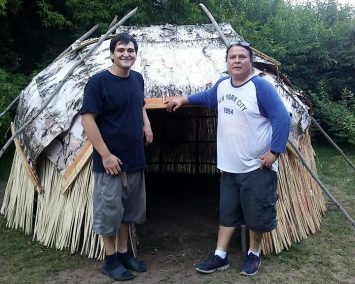
Figure 2: Wayne Valliere Jr. and Sr. at a wigwam constructed in the summer of 2017. Photo: Lawrence Mann.
Culturally-Specific Sustainability and Decolonization
Sustainability is not a singular complex, but rather inclusive of pluralistic and culturally-specific phenomena that “operate within different socio-cultural contexts and build upon differing cultural constructions, economic models, traditional and customary environmental use, and political rights” (Frandy and Cederström 2017, 218). Sustainable systems can only exist where there is balance between systems of culture, environment, economy, and political governance. Like a table, balance must be achieved with all of the various legs for stability. Striving towards sustainability can lead us in different directions, as different economic models, types of environments, cultural norms, and governance structures all can support different kinds of sustainable systems. Sustainabilities are often at odds with each other, and can work against each other. What is sustainable management for one culture may undermine fundamental resources needed by another cultural group. The Walleye War of northern Wisconsin, the Makah whale hunt, the water protectors at Standing Rock, the Ellos Deatnu salmon camp, and countless other Indigenous land use conflicts all reflect contestations over what sustainability means across cultural lines. Nor do these differences reflect a strict Western-Indigenous binary. Alternative notions of sustainable resource use and management have also been explored, for instance, in the Ozarks in communities of trappers (Brady 1994) and in terms of wild horse management (Rikoon & Albee 1998), or among subsistence poachers in the Lake Superior region (Frandy 2007) and Maine (Ives 1988).
Despite recent efforts to be more inclusive of diverse peoples, the discourse that has emerged in sustainability studies has remained rather Western-centered in its orientation. Indigenous peoples are often subjected to dismissal: their cultural practices, subsistence-based economies, and land-use patterns are often branded as unsustainable, in spite of having successfully managed the natural environment for generations, centuries, and even millennia. “Sustainability” and “conservation” are sometimes deployed as weapons that advocate for continued and even escalated colonization, forced cultural assimilation, and resource theft or appropriation. This kind of “green colonialism” rationalizes appropriation of Indigenous resources (water, timber, minerals, fish and game) for the sustenance of an exogenous colonial state under a rationale of environmentalism and sustainability (Frandy, forthcoming). Drawing on racist tropes that assume that traditional environmental management and economic structures are inherently inferior to the capitalist systems of Western Europe and North America (DeLoughery & Handley 2011, 12; Feltault 2007, 97), colonial logics suggest it is the moral responsibility of Western states to promote their supposedly innovative or superior models of sustainability to the Indigenous world. At heart, these are acts of colonization.
As Taiaiake Alfred and Jeff Corntassel write, settler colonialism today does not necessarily work to “eradicate the physical signs of Indigenous peoples as human bodies,” but instead tries to “eradicate their existence as peoples through the erasure of the histories and geographies that provide the foundation for Indigenous cultural identities and sense of self” (2005, 598). Andrea Smith suggests that this erasure is essential in the sustenance of white supremacy, arguing that “indigenous peoples must disappear. In fact, they must always be disappearing, in order to allow non-indigenous people the rightful claim over this land” (2006, 68). Erasing the efficacy of Indigenous sustainabilities proffers justification for colonial displacement. While perhaps less apparent than the colonialism of just a few generations ago (at least to settler communities), attempts to erase, subsume, or appropriate the expertise, the history, and the culture of Indigenous peoples are still as insidious now and require ongoing work by Indigenous peoples and allies to stop and eventually reverse the harms of colonization.
Decolonization—a complex abstraction still much debated in the field of Indigenous studies—works to do just that. Fundamentally, as Eve Tuck and K. Wayne Yang remind us in their powerful polemic “Decolonization is Not a Metaphor,” decolonization refers to the literal abdication of power from occupying colonial states, ceding power and land back into the hands of their rightful Indigenous owners (2012, 21). Yet decolonization involves more than land and political governance. For decades, Indigenous and postcolonial scholars have written about decolonizing the mind (Fanon 1963; Ngũgĩ 1986), decolonizing research methodologies (Tuhiwai Smith 2012; Kovach 2009; Wilson 2008), decolonizing education (Battiste 2013; Patel 2016), and more.
Yet this task is neither easy nor straightforward. Even Indigenous-led efforts to promote Indigenous epistemological growth in Western educational institutions have been critiqued by some Indigenous scholars. Tuck and Yang have criticized “the ease with which the language of decolonization has been superficially adopted into education and other social sciences” (2012, 2), and Tuck and Rubén Gaztambide-Fernández argue that there exists a “curricular project of replacement, which aims to vanish Indigenous peoples and replace them with settlers” (2013, 73). N. Martin Nakata et al. have critiqued “the problematic contexts” of teaching Indigenous Studies in university settings (2012, 122), pointing to the failures of many contemporary Indigenous Studies pedagogies (including Critical Theory, social justice models, and Indigenous contestation) to advance Indigenous-centered epistemological traditions. Vilsoni Hereniko (2000) has raised the issue of whether a colonized mind can ever be decolonized—a point Konai Helu Thaman both agrees with and contests (2003, 1–3).
Decolonization, whether of the mind, of research methodologies, of education, or in the abstract is not simply a return to an idealized vision of pre-colonial times. In her discussion of decolonizing Pacific studies, Thaman notes:
For me, decolonizing Pacific studies is important because (1) it is about acknowledging and recognizing the dominance of western philosophy, content, and pedagogy in the lives and the education of Pacific peoples; (2) it is about valuing alternative ways of thinking about our world, particularly those rooted in the indigenous cultures of Oceanic peoples; and (3) it is about developing a new philosophy of education that is culturally inclusive and gender sensitive. (2003, 3)
In Lac du Flambeau, emphasis on the latter two points helps create a forward-looking model of decolonization that responsively embraces and integrates the inevitable changes in society and the environment. These paradigms implicitly address a critique of Nakata et al. that invoke problematic “modes of knowledge authority that valorise markers of authenticity” that are rooted in the past, or perhaps our perceptions of the past (2012, 129). Despite the colonial stereotype of Indigenous people as remnants of the past, Indigenous people have long looked toward the future. The notion of “seven generation stewardship,” a concept adapted from the Great Law of Peace of the Haudenosaunee, considers long-term future impacts of the actions we conduct today. Decolonization is similarly forward looking, purposefully amplifying the value of historical and living culture, and strategically participating in those aspects of culture today in order to actively shape the future world of Indigenous descendants. Valliere explains:
It’s like this: by knowing where you’ve been, you’ll have a greater understanding on where you’re going. So it’s going to add strength to a solid foundation of their identity…. ‘I don’t have to lose my Native values to understand Western society and be part of it. I can be the best of both worlds.’ (Cederström et al. 2015).
Indigenous cultural worldviews and knowledge traditions are not remnants of the past, but living and dynamic aspects of the contemporary world that offer practical and viable solutions for problems on a global scale.
Although “tradition” is popularly used in ways that suggests continuity, conservatism, and the past, for folklorists tradition represents a dynamic dialogue between the past, present, and future. Henry Glassie considers tradition to be “the creation of the future out of the past” (1995, 395) and Barbro Klein and Mats Widbom remind us in the title of their classic study of Swedish folk art that “all tradition is change” (1994). Tradition is rooted but changing; it is shared by communities yet shaped by individuals; it can be emergent, invented, or revitalized, but it exists in dialogue with the past. All people have traditions and participate in tradition every day, yet the word is sometimes deployed to describe marginalized groups in ways that are more limiting than liberatory, which sometimes leads to objections by Indigenous scholars, artists, and activists (Mallon 2016). When we speak of knowledge traditions or sustainability traditions, we aim to call awareness to the historical evolution of knowledge systems and performed belief. Western concepts of sustainability and Western concepts of what education should entail are not simple realities, but rather have evolved over centuries as complex cultural performances of shared and negotiated belief, values, and power that are firmly rooted in traditions.
Decolonizing sustainability education requires not only a restorative systemic shift towards Indigenous sustainabilities, but also requires educators to facilitate this shift through Indigenous-centered pedagogies and methods of knowledge production. Although this concept is large, vague, and slippery, there are many localized and culturally-specific ways this decolonization might occur. With the remainder of this work, we wish to discuss one way in which sustainability education is decolonized and Indigenized in Lac du Flambeau. Our cultural team’s leader, Wayne Valliere, often repeats a phrase that grounds this theory: “it’s not about teaching the culture… it’s about teaching culturally.” How sustainability is taught shapes how sustainability is performed in the world, and the failure to embrace and nurture multicultural pedagogical strategies will lead the concept of sustainability to be further exploited to advance colonial agendas.
Sustainability and Anishinaabewin at the Winter Games
On the Monday of games week, approximately twenty-five fifth graders arrive at 9:00 a.m. In an outdoor classroom, their teacher Wayne Valliere briefly introduces the history and cultural importance of the games that they will soon compete in. During the morning session, boys and girls divide into two groups and rotate through four competitions for medals: gooniikaa-ginebig ataadiiwin (the snowsnake game), dakobijigan-minawaa zhiimaagan (the hoop-and-spear game), apaginaatig ataadiiwin (the atlatl), and agimag gagwejikanidiwin (snowshoe races). Around noon, a traditional lunch of wild rice soup, venison stew, or walleye is served indoors. In the afternoon, students rotate through more outdoor activity stations: archery, traditional lacrosse, muskie spearing, a presentation by Great Lakes Intertribal Fish and Wildlife Commission or the Wisconsin Department of Natural Resources about trapping, a BB-gun shooting range staffed by the Lac du Flambeau Tribal Police, or storytelling in the Ojibwe winter lodge built by Valliere and his team in 2014. The archery station becomes especially competitive when adults begin pinning dollar bills onto deer targets—any student that hits the money keeps it.
Throughout the day, Valliere teaches the students about resilience, survivance, and sustainabilities: cultural, linguistic, and environmental. These are not distinct from each other. Hunting, for example, is involved with the maintenance of a sustainable environment. With the careful and mindful harvest of some species, room exists for other species to exist and flourish. Traditional Anishinaabe hunting helps preserve the biological diversity of the forest ecosystems, while serving as an important economic and cultural resource for Anishinaabe people (Frandy and Cederström 2017, 222). Valliere emphasizes that the choices they make every day affect the environment, that it is there to be used, but that it must be used in the right way. He reminds his students that plants and animals are not just resources to be harvested, but relatives to be respected and cared for accordingly. The Games are part of this education. Valliere teaches the students the history of Ojibweg Bibooni-Ataadiiwin: their origins, their roles in society and especially the education of young hunters, and the reasons they were lost to the community.
One crucial aspect of these games is that they are distinctly a revitalization effort. When the Winter Games began in 2012, the snowsnake game had not been played on the Lac du Flambeau reservation for over 100 years. The apaaginaatig (atlatl) was likely not used in Lac du Flambeau for centuries. The last known game of traditional lacrosse was played in 1910. These games physically embody the cultural history of Anishinaabe people, and the annual performance of these games puts Anishinaabe people into direct relationship with their ancestors, their environments, and Anishinaabewin—the Anishinaabe way of life. Revitalization is not simply about reviving cultural artifacts, but instead involves restoring broader systems of sustainable autonomy for Anishinaabe people. When young people can connect history and tradition to their lived experiences, they create meaning and depth in their own lives. And by sharing in these experiences with each other and with the non-human persons of this world (including plants, animals, and spirits), they create a stronger community that is better positioned within a traditional web of relations to determine what decolonization and sustainability means for them and their community.
Each day of the Games a new grade comes out, sixth, seventh, and eighth, with students running through a similar routine, competing for medals. On Friday, fourth graders from Lac du Flambeau join fourth graders from other area grade schools to spend their first year at the Winter Games. While Lac du Flambeau public school is 98% Native American, other area schools are predominantly white. For white students, the games are a point of access to better learn about their Anishinaabe neighbors. Because the number of students on this day can reach upwards of 200, students rotate through all the stations at once, and the games are for practice and fun rather than competition. The Lac du Flambeau students return every year, and with the Games now entering their seventh year, several cohorts have grown up with the event. The longer the Games have run, the more positivity and excitement students have brought to them.
A comprehensive culturally-responsive curriculum exists within Ojibweg Bibooni-Ataadiiwin. Knowledge production and transmission always occurs within cultural frameworks. The dominance of Western cultural frameworks within formal educational settings has created the false illusion that Western relationships with knowledge, interpretation, and methods are universal and correct. This presumed universality (or superiority) of Western cultural norms is entangled and complicit with broader ethnocentric rationalizations of colonization. Indigenous learning environments tend to be less hierarchical, more focused on relationality, more hands-on, more integrative of cultural teachings, more local in concern, and more intergenerational than Western learning environments. Valliere’s classroom, for instance, is oriented in a circle, which he teaches in the middle of, because “that’s how knowledge flows, that’s how creation flows, in a circle” (Cederström et al. 2015).
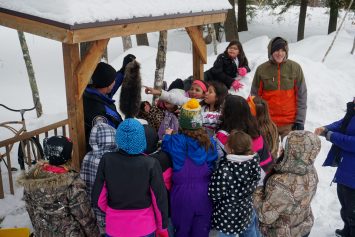
Figure 6: The Wisconsin DNR demonstrates trapping techniques (5th graders, 2016). Photo: Tim Frandy.
Taking students into the northern forests, Valliere works with students to recognize, interact with, and make use of the environment that surrounds them. Students harvest different woods for snowsnakes, spears, hoops, and spear-throwers. As they do so, they develop new relationships with the environment—the plants and animals they work with—learning to see them as the complex beings they are. They begin to recognize a specific girth of basswood tree as a good place to harvest fiber for cordage; they start to read a tree’s grain from its bark and learn how one should harvest to ensure it is done sustainably. Some years, students help construct the equipment for the games in their arts and culture classes, learning the sophisticated technologies and craftsmanship behind these instruments, while tangibly dispelling any damaging or false stereotypes of “primitive” Indigenous craft. Creating tools that the students then use as part of the Winter Games and discussing the implements and the environment, often in the Ojibwe language, are all part of the curriculum that Valliere uses to teach culturally. These crafts encourage students to think creatively about plants and animal and to see their environment in traditional ways that value resourceful and adaptive use of natural materials. As Valliere says, “We use things like the birchbark canoe building and use the Ojibwe Winter Games to reinforce Ojibwe words so they learn their language and, at the same time, their identity” (Valliere 2014).
By participating in the Games, students learn culturally about snow, ice, and cold. They learn how efficient snowshoes can be as a mode of transport, and how adept snowshoeing is an art of balance and careful motion. They learn to read lake ice in different years, be it a slick and hard layer of ice, a bed of slush hidden beneath the snow and atop the hard ice, or even water trapped between two ice layers. They learn that our mobility in snow and across the ice, and our ability to ice-fish or hunt in the winter, are dependent on the weather. They learn to pay attention to the weather because it speaks to us and tells us what will happen in the days, weeks, and months to come. They learn to pay attention to the animals, who tell us what weather is approaching. And they learn about the cold, testing the limits of their comfort and learning the numerous tricks there are to stay warm in bitter weather. The performative aspect of the Games creates experiential knowledge that students carry with them from one year to the next as they accept and embrace winter as an important time of the year, a time for sacred stories, a time for certain kinds of outdoor work, a time of meditation and contemplation, a time when one may go outward to work but then draw inward with oneself and the closest of family and friends. Their experiences shape their sense of time, of place, of responsibility, of identity. And it is through these principles that students come to acquire and transmit knowledge. At the Ojibwe Winter Games, students live the culture instead of merely learning about it: they create meaning in their own lives, they exercise agency in their own education, and they share their experiences with their fellow classmates, teachers, elders, and community members.
Whereas models of cultural preservation or conservation often seek to sustain the present into the future, Ojibweg Bibooni-Ataadiiwin seek actively to create new sustainabilities for the community that are anchored in the sustainabilities of the past. Not simply concerned with either the new or the old, sustainability—like tradition—invites a dialogue between the past, present, and future, as community members selectively make purposeful decisions on what is worthy of sustaining and what is not. The Ojibwe Winter Games are not simply about revisiting historical aspects of Anishinaabe culture. They are not re-enactment, nor a participatory historical theme park. Their purpose is not so much to learn about the past, but rather to find new traditional ways to live in the present, and to find meaning in new contexts for traditional culture today. By selectively and critically revitalizing Anishinaabe traditional culture, we can find ways to manage ourselves in order to live better within the environment rather than manage the environment in ways to suit us. This is what sustainability education looks like at the Games.
Our Collaboration
Linda Tuhiwai Smith, writing about ongoing Indigenous movements globally, says that these movements involve “a revitalization and reformulation of culture and tradition; an increased participation in and articulate rejection of Western institutions; and a focus on strategic relations and alliances with non-indigenous groups” (2012, 114). It is precisely this approach that Valliere and others in Lac du Flambeau are taking as they work towards decolonization, the “long-term process involving the bureaucratic, cultural, linguistic and psychological divesting of colonial power” (Tuhiwai Smith 2012, 101). Since the first year of Ojibweg Bibooni-Ataadiiwin, folklorists from the University of Wisconsin–Madison have been working with the community in both formal and informal partnership and alliance to support the Games, encourage cultural revitalization, and further decolonization in the community.
Folklorists have a long history of collaborative community relationships, in what is now sometimes called reciprocal ethnography. This legacy traces through influential figures such as Benjamin Botkin, Archie Green, Américo Paredes, and Deborah Kodish, who all have conducted and curated fieldwork for agendas that advance social justice for the marginalized communities in which they worked, in partnership with the communities for whom they worked. In response to the “extractive industry” of much academic work, in 1988 the American Folklore Society approved a statement of ethics stating, “In research, folklorists’ primary responsibility is to those they study” (American Folklore Society). Rather than the empirical study of human cultures, folklorists’ primary obligation is to serve the community we are working with. This can take many forms.
The collaboration between folklorists at UW-Madison and the community in Lac du Flambeau has resulted in several projects, each one growing naturally out of our previous work. We have, to date, assisted in running seven birchbark canoe building workshops (each lasting 3–12 months), thus teaching a threatened master art to a younger generation of builders (Frandy and Cederström 2017; Cederström et al. 2016; Frandy 2015; Cederström et al. 2015). We have collaborated on summer culture camps, supporting elders and artists as they teach buckskin tanning, birchbark basketry, traditional outdoor cooking, language, lacrosse stick making, and the traditional game of lacrosse. We have worked together with Valliere and others to teach wigwam and winter lodge building, and to support seasonal food harvesting camps (Cederström, DuBois, and Frandy 2016). We have collaborated on numerous grants; worked together on films, journalistic pieces, and publications; we have gotten our hands dirty with the arduous behind-the-scenes labor of these projects; and we have discussed for countless hours why these projects seem to be working and how we can improve them. These kinds of cultural programs have existed for decades, and our work is an outgrowth of these prior efforts. Our projects have led to replicable models of programs in Lac du Flambeau: versions of our canoe-projects have been introduced in three other communities who are also trying to repatriate the craft. Our work at the Ojibwe Winter Games, conversations with other Indigenous communities, and our online documentation has also influenced—to greater or lesser extent—the creation of at least ten similar games or winter cultural camps across the region.
It’s important to note that among our team of folklorists no one is a tribal member. Although some of us have various personal connections to Indigenous communities, we have neither the right to assert nor an interest in asserting our own vision of how Anishinaabe revitalization or decolonization should take form. Still, our partnership is valued in this process, whether it’s our assistance in writing grants, documenting events, or quartering six-foot cedar logs and carrying them out of a swamp. In a previous article, our team proposed the following four elements as essential tools in the move towards educational sovereignty that has been having restorative effects on Anishinaabewin:
- Programs should be community-initiated and community-driven.
- Educators should be encouraged and empowered to “teach culturally,” rather than simply “teach culture.”
- Collaborating folklorists should respect the leadership and decision-making authority of their Indigenous partners.
- Collaborations should be long term and flexible, negotiating the evolving needs of the community, of folklorists, and of funders to ensure ongoing viability. (Cederström et al. 2016)
These four elements provide a template for folklorists and other educators to work with communities to move towards a sustainable model of collaboration. To this we would add that collaborators must always be allies who validate and legitimize the work of the community, whether they focus on research, teaching, outreach, or any other imaginable reason. White people—and it is almost always white people—must discard any savior-complex we may carry and be constantly aiming to work ourselves out of a job in the communities with which we partner. Our responsibility must be to the community we are collaborating with. Always.
As non-tribal members, we are there to assist when called upon. We set up the games on the ice. And sometimes tear them down and move them when the ice is not strong enough. We shovel snow, staff the various stations, retrieve arrows and snowsnakes, keep score, assist teachers. We serve venison stew, hand out hot chocolate, award medals. We are guests and we are volunteers, so we shut up and we listen and we work hard.
As representatives of the University of Wisconsin–Madison, a predominantly white land-grant institution located on Ho-Chunk land in southern Wisconsin, we are in a position of power. While we are an extra set of hands during the week of the games, our efforts are not constrained to one week every winter. Indeed, that work extends throughout the year and includes grant-writing, documentation, and the expansion of the community’s mission through related projects. We lend our skills as academics to co-write grants to support the various efforts in Lac du Flambeau. Those grants help to fund transportation, lodging, and, most importantly, compensate the Indigenous experts who give their time and knowledge. We also lend our university affiliation to validate the transformative work occurring in Lac du Flambeau. That validation is not necessarily for the people of Lac du Flambeau. Theirs is a community with diverse needs and differing opinions about what those needs are and how to meet them, but they know what they are doing works. The validation is rather for others, outside of the community, who look skeptically upon Indigenous centered sustainabilities and pedagogies.
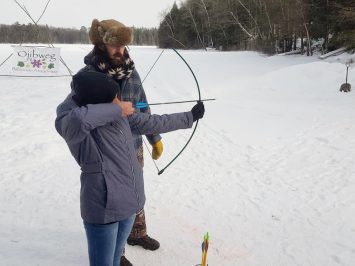
Figure 9: Colin Gioia Connors instructing an 8th grader on the archery range (2018). Photo: Aaron Wilde.
As folklorists, we are trained in responsible ethnographic documentation. During the week we document the Games; we take pictures and video and upload them to social media sites for the students, their parents, and other community members to see and share. These materials supplement an ongoing discussion in the community about decolonization, cultural revitalization, and Anishinaabe sustainabilities and have been shared with local news organizations, community elders, Indigenous nations across the Upper Midwest, and public schools throughout Wisconsin. We bring these materials into our classrooms and into our fields of scholarship in an effort to convey the importance and efficacy of these projects to new audiences. We try to translate why these Games and these revitalizations are important to a largely non-Indigenous audience, who do not have the life experiences to understand the urgency of this work, so that elite institutions, funders, and governing bodies might better understand its value and, in turn, improve strategic investments in decolonizing programs. We promote the Games in the event that they may inspire other Indigenous communities to advance their own revitalization work in their own communities.
In the past six years our documentation of the Games has largely subsided. Today, Valliere and his team of educators and apprentices are documenting the Games themselves. Our expertise is no longer needed to the same extent, or at least in the same way, as it once was. The same can be said for our volunteer work during the week of the Games. Students do not need the games explained to them. Teachers do not need to be reminded about the rules. We have begun to work ourselves out of a job, as Valliere and his culture crew have transformed the games from written accounts in ethnographic texts to a living tradition in the community today.
The needs and wants of the community have changed, and so what we offer has changed with it. To expand the successes of the project, we have begun organizing related events. In 2016, for example, folklorist Colin Gioia Connors secured a grant to work with the community organizers in Lac du Flambeau to bring the games to Madison in an event that was called “Ojibwe Winter Games @ UW-Madison.” Connors, with the assistance of other folklorists on campus, ensured that Valliere, his apprentice Lawrence Mann, and several students from the Lac du Flambeau public school were involved. In this instance, Connors lent his support as a grant-writer, securing funding to pay for the community members from Lac du Flambeau to come to Madison to share their cultural knowledge and expertise. He also worked with UW-Madison’s Dejope Residence Hall—which opened in 2012 and celebrates Indigenous peoples in Wisconsin—to purchase snowsnakes for use by students and to create a permanent snowsnake exhibition in the dormitory.
By bringing the Games to Madison, Connors amplified the knowledge and expertise of the community he had spent years working with, ceded power to Indigenous peoples, and participated in an active agenda of de-erasure of Indigenous peoples from American universities. This work stresses that Indigenous people are still here; they are taking control of their education and living their culture. As Anishinaabe educator Carol Amour says,
what I see happening is that more and more students are really demonstrating that sense of efficacy that we really can make a difference and our culture has a lot to teach—not just us, but look at all these people that are coming to learn from us. (Amour 2015).
Hosting the Games at the University of Wisconsin–Madison is valuable because the event is not staged for an audience, but rather created to facilitate learning. Valliere, his culture crew, and eighth-grade students teach these games to hundreds of university students, and in doing so reveal the systemic erasure that is endemic in university environments and, at least for the students on that ice, helped present a different educational approach.
Connors’ collaboration with Valliere resulted in a short video by the University of Wisconsin–Madison’s communications division publicly available on YouTube, as well as a website featuring the Winter Games in Lac du Flambeau. This website documents how the games were played in the 19th century and how they are played today, including rules, explanations, and video demonstrations of how to make the game equipment. The site serves a double purpose: first, it validates the Games to non-Indigenous communities through education. Second, it serves Indigenous communities as a resource for building and carrying the games forward while connecting the past to the present and future of the Games.
For university students, this point of access to Anishinaabe culture offers them a powerful and experiential way to understand Native cultures today. They are introduced to Indigenous concepts of sustainability in a way that both demonstrates and validates the expertise of Indigenous people. Valliere sees events such as the one in Madison as opportunities to teach outsiders about the culture and the threats to it. “If you’re working with a hundred university students,” Valliere explains, “you don’t know who among them will be doctors, or ecologists, or politicians. But some of them will be. And maybe in 20–30 years, they heard about some threat to a manoominikaang [a wild rice bed], or to our water, or to our forests. Maybe they will think back on these Games and remember how these things are important to our way of life, and they will be in a position that they can help stand up for our people” (Valliere 2015).
For the students from Lac du Flambeau, this curriculum of decolonization has reinforced the value and worth of their culture and language. That reinforcement has helped students center themselves in their culture: as Amour says simply, “you can see the difference in terms of the kids’ confidence and engagement” (Amour 2015). The boost in confidence, engagement, and self-esteem in turn is an essential aspect of encouraging students to re-engage with their traditional cultural practice, knowledge, and worldview. Amour continues,
If you see your culture in your school, if you see your culture in your curriculum, if you see your culture valued, if you see your culture around you, it says to you, “My culture is important.” And it says, then, to you, “I have value. I am of worth” (Cederström, DuBois, and Frandy 2016).
While difficult to measure, Valliere and the teachers at Lac du Flambeau emphasize the real, positive impact the Games have on children’s self esteem and the incredible effects that improving self-esteem have on populations dealing with historical trauma. Creating and sustaining positive self-identity has, according to teachers at Lac du Flambeau, helped students succeed in the classroom. And outside of the classroom, the Games encourage students to view Lac du Flambeau and their wider community as a place worth returning to as adults, a place to build a career and raise a family, and a place with a culture and knowledge that are valuable and worth sustaining. The Ojibwe Winter Games are not just about teaching sustainability, but practicing it.
Contested Sustainabilities
Colonialism is a complex condition in which we all live. The universities in which we work have long served as an advisory arm of colonial administration regimes, and they have been active agents in creating disempowering and counterproductive models of Indigenous research that stress paternalistic attitudes towards objectified Indigenous peoples. Our responsibility to the communities we partner with includes dismantling the very systems in which we work in order to advance decolonization efforts by Indigenous communities. Although decolonization must manifest itself under Indigenous leadership, the responsibility falls on us to use our positions of power to create a system of education that can support and sustain Indigenous knowledge traditions, and to abdicate our own inherited power in our dealings with the community. On an individual level, at least, this is not as difficult as it may seem when one takes the time to listen to understand.
For decolonization to ever take hold, though, it must not only happen individually, but also systemically—a much more arduous task. Decolonization, as noted above, is often contested by individuals and systems in power. Even the idea of sustainability as pluralistic and culturally-specific is a disputed concept. For many institutions, sustainability means preservation. Snowsnakes and canoes are meant to be preserved as artifacts and pieces of art. These works are “sustained” for future cohorts of students on campus when put on display, untouched, unsullied, unused. But for Valliere, these pieces of art are tools and instruments specifically meant for use. Sustainability requires that the culture be lived and the environment be experienced. Sustainability means taking the snowsnakes out on the ice. It means allowing Wunk Sheek, a student organization on the UW-Madison campus serving Indigenous students, to use the canoe otherwise on display in Dejope Residence Hall. Sustainability does not preclude the display of these works, but it requires using them in the right way. For Valliere and his team, Anishinaabewin is not just a culture to be observed and admired, but a culture to be lived and shared. As folklorists and university professionals, we can assist in transforming Valliere’s vision of sustainability into viable policy and practice within a historically colonizing institution and beyond.
Although it is not the place of colonizing peoples to lead in this process, we believe that there are pathways by which settler communities can liberate ourselves from the colonial system in which we all live. As Tuck and Yang examine, colonization is not a metaphor for oppression and simply recognizing colonization is not enough (2012, 19–22). We must be willing to cede space, to facilitate and support the repatriation of land, language, and culture, to amplify Indigenous voices, to listen, to assist when asked, and to respect and validate the expertise of the communities with which we work.
This kind of work can take many forms. As educators, we work to center Indigenous voices so our non-Native students can better listen and understand, we work to make space for our Indigenous students within Western educational institutions, and we work for the growth and development of Indigenous-centered discourses, rhetorics, logics, and methods. As scholars, we work to explain why Indigenous sustainabilities are legitimate, why they have been historically subverted by colonizing peoples, and how these subversions persevere even today. We work to persuade others to center Indigenous perspectives in their own work, and we work to convince funders and government agencies that decolonizing sustainabilities and education is effective, if not essential, to secure a sustainable future for us all. As public folklorists, we aim to put the needs of the community first with a sense of humility, to decenter ourselves from this process, and to be willing to pick up a shovel—because the sheer act of making a snowsnake course is significantly more important in actual decolonization in a real community than all of our pontificating and theorizing.
In 2016, our team presented a poster on our collaborative projects at a conference in an attempt to promote the positive effect cultural revitalization can have on a community’s health and wellbeing. After explaining the project to one individual, we were asked “what we actually did.” The question flummoxed us. This particular person was not impressed with the amount of shoveling we did, nor with the difficulties of trying to teach archery to a 10-year old who has never shot a bow before. We believe the importance of our work lies in radical humility—knowing full well that we run the risk of sounding anything but humble. Radical humility requires that we always understand that this experience is not about us, that we recognize that there is always more work to be done to be better collaborators, and that our greatest value in these efforts sometimes lies in picking up a shovel to help facilitate what Jeff Corntassel calls “everyday acts of resurgence” (Corntassel 2012, 88). “What we actually do” is show up, help where we can, and be attentive, humble, and respectful. In the words of Carol Amour, what we do signals to the youth that “we are all teachers and all learners here” (Cederström, DuBois, and Frandy 2016), and that education is about creating knowledge and meaning together, not listening to the person with the most degrees.
And so, on some days, we write articles about decolonizing sustainability education. On others, we move games from melting ice to a snow-covered field. This year, in contrast to last, temperatures didn’t reach double digits and the Games were held on the ice. Students threw the snowsnakes, raced around a course on snowshoes, and shot BB guns. They listened to traditional stories from their own culture and heard traditional stories from other groups, including Nordic mythology and traditional stories of the Sámi—the Indigenous peoples living in what are now considered the northern Nordic countries. Some years, the ice melts or the snow piles too high or the temperatures drop too low or the sun shines just right. But every year, Wayne Valliere, students, elders, and community members arrive at Ojibweg Bibooni-Ataadiiwin to take part in the Games. And every year, a group of folklorists and students from UW-Madison heads up to Lac du Flambeau to volunteer our energies. And through our combined efforts, a new cohort of students get the opportunity to live their culture in their winter environment and participate in sustaining their language, their traditions, their environment, and their way of life.
Works Cited
Alfred, Taiaiake and Jeff Corntassel. 2005. “Being Indigenous: Resurgences against Contemporary Colonialism.” Government and Opposition: An International Journal of Comparative Politics. 40.4: 597–614.
American Folklore Society. 1988. “AFS Statement on Ethics: Principles of Professional Responsibility.” AFSNews, New Series, 17.1. http://www.afsnet.org/default.asp?page=Ethics.
Amour, Carol. September 4, 2015. Recorded interview conducted by B. Marcus Cederström, Thomas A. DuBois, and Tim Frandy. Lac du Flambeau, Wisconsin.
Battiste, Marie. 2013. Decolonizing Education: Nourishing the Learning Spirit. Saskatoon: Purich.
Brady, Erika. 1994. “‘The River’s Like Our Back Yard:’ Tourism and Cultural Identities in the Ozark National Scenic Riverways.” In Ed. Mary Hufford, Conserving Culture: A New Discourse on Heritage. Urbana: University of Illinois Press: 138–151.
Cederström, B. Marcus, Thomas A. DuBois, Tim Frandy, and Colin Connors. 2016. “Heritage Repatriation and Educational Sovereignty at an Ojibwe Public School.” Journal of Folklore and Education 3: 31–41. http://www.locallearningnetwork.org/heritage-repatriation-and-educational-sovereignty-at-an-ojibwe-public-school/
Cederström, Marcus, Thomas DuBois, Colin Connors, Tim Frandy, and Carrie Roy. 2015. Wiigwaasi-Jiimaan: These Canoes Carry Culture. Film. https://vimeo.com/145946701.
Cederström, Marcus, Thomas DuBois, and Tim Frandy. 2016. “Birchbark Canoes and Wild Rice.” Film. https://vimeo.com/170565548.
Corntassel, Jeff. 2012. “Re-envisioning Resurgence: Indigenous Pathways to Decolonization and Sustainable Self-Determination.” Decolonization: Indigeneity, Education, and Society 1.1: 86-101.
DeLoughrey, Elizabeth M. and George B. Handley. 2011. Postcolonial Ecologies: Literatures of the Environment. Oxford: Oxford University Press.
Fanon, Frantz. 1963. The Wretched of the Earth. New York: Grove Press.
Feltaut, Kelly. 2006. “Development Folklife: Human Security and Cultural Conservation.” Journal of American Folklore 119: 90–110.
Frandy, Tim. 2015. “Birchbark Canoe Building and Decolonizing Health.” The Community Psychologist. 48.1: 25–27.
Frandy, Tim. 2009. “Ecology and Identity in the Northwoods: Finnish-American Poaching Techniques and Narratives.” In Wild Games: Interdisciplinary Approaches to Hunting and Fishing in North America. Ed. Eric Eliason & Dennis Cutchins. University of Tennessee Press: 166–182.
Frandy, Tim. Forthcoming. “Mas Amas Diehtá Maid Oarri Borrá: Constructing Sustainability in Sápmi.” In Ed. Christopher Oscarson, Nordic Nature/Cultures. Seattle: University of Washington Press.
Frandy, Tim and B. Marcus Cederström. 2017. “Sustainable Power: Decolonising Sustainability Through Anishinaabe Epistemologies and Public Humanities Programming.” In Going Beyond: Perceptions of Sustainability in Heritage Studies, eds. Marie-Theres Albert, Francesco Bandarin, and Ana Pereira Roders, 217–230. Springer International Publishing.
Glassie, Henry. 1995. “Tradition.” The Journal of American Folklore 108.430: 395–412.
Hereniko, Vilsoni. 2000. “Summary of Panel Discussion on Decolonizing Pacific Studies. http://www.hawaii.edu/cpis/conference/preconfdisc.html
Ives, Edward D. 1988. George Magoon and the Down East Game War: History, Folklore, and the Law. Urbana: University of Illinois Press.
Klein, Barbro and Mats Widbom, eds. 1994. Swedish Folk Art: All Tradition is Change. New York : H.N. Abrams.
Kovach, Margaret. 2009. Indigenous Methodologies: Characteristics, Conversations, and Contexts. Toronto: University of Toronto Press.
Malon, Sean. 2016. “Opinion: Why We Should Beware the Word ‘Traditional.’” Blog. December 20. http://blog.tepapa.govt.nz/2016/12/20/opinion-why-we-should-beware-of-the-word-traditional/
Nakata, N. Martin, Victoria Nakata, Sarah Keech, and Reuben Bolt. 2012. “Decolonial Goals and Pedagogies for Indigenous Studies.” Decolonization: Indigeneity, Education & Society 1.1: 120–140.
Ngũgĩ wa Thiongʼo. 1986. Decolonising the Mind: The Politics of Language in African Literature. London: J. Currey.
Patel, Leigh. 2016. Decolonizing Educational Research: From Ownership to Answerability. New York: Routledge.
Rikoon, Sandy and Robin Albee. 1998. “‘Wild and Free, Leave ‘Em Be’: Wild Horses and the Struggle over Nature in the Missouri Ozarks.” Journal of Folklore Research 35.3: 203–222.
Smith, Andrea. 2006. “Heteropatriarchy and the Three Pillars of White Supremacy. In Color of Violence: INCITE! Women of Color Against Violence. Cambridge, MA: South End Press: 66–73.
Thaman, Konai Helu. 2003. “Decolonizing Pacific Studies: Indigenous Perspectives, Knowledge, and Wisdom in Higher Education.” The Contemporary Pacific 15.1: 1–17.
Tuck, Eve and Rubén A. Gaztambide-Fernández. 2013. “Curriculum, Replacement, and Settler Futurity.” Journal of Curriculum Theorizing 29.1: 72–89.
Tuck, Eve and K. Wayne Yang. 2012. “Decolonization is Not a Metaphor.” Decolonization: Indigeneity, Education & Society 1.1: 1–40.
Tuhiwai Smith, Linda. 2012. Decolonizing Methodologies: Research and Indigenous Peoples (2nd edition). London: Zed Books.
University of Wisconsin–Madison. February 24, 2016. “Winter games connect Ojibwe culture with UW-Madison.” YouTube, uploaded by uwmadison, https://youtu.be/zTsdbDyNCHs.
Wilson, Shawn. 2008. Research is Ceremony: Indigenous Research Methods. Winnipeg: Fernwood.
Valliere, Wayne (Mino-Giizhig). February 20, 2014. Recorded interview conducted by B. Marcus Cederström, Colin Gioia Connors, and Thomas A. DuBois. Lac du Flambeau, Wisconsin.
Valliere, Wayne (Mino-Giizhig). 2015. Personal communication with Tim Frandy. Lac du Flambeau, Wisconsin.







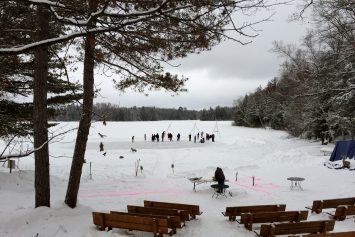
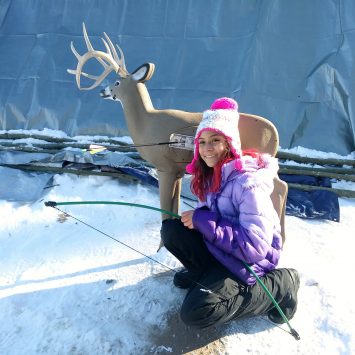
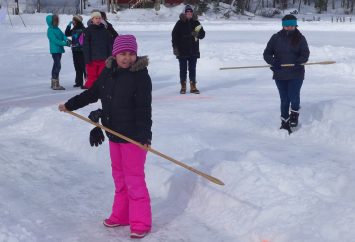
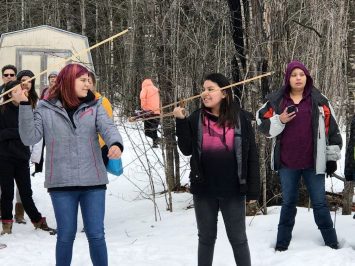
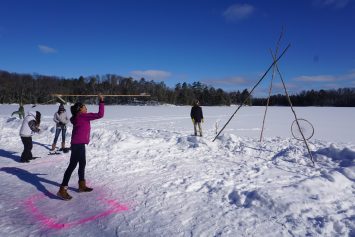
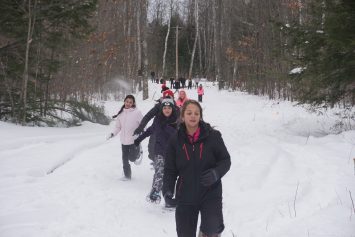
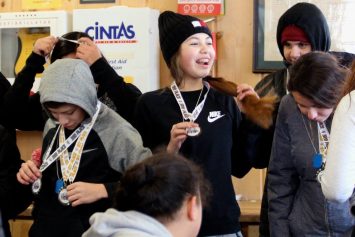
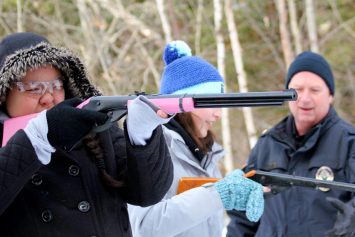



 B. Marcus Cederström is the community curator of Nordic-American folklore in the Department of German, Nordic, and Slavic at the University of Wisconsin–Madison. His research includes articles and multimedia productions about immigration to the United States, identity formation, North American Indigenous communities, and sustainability.
B. Marcus Cederström is the community curator of Nordic-American folklore in the Department of German, Nordic, and Slavic at the University of Wisconsin–Madison. His research includes articles and multimedia productions about immigration to the United States, identity formation, North American Indigenous communities, and sustainability.  Tim Frandy is an Assistant Professor of Folk Studies at Western Kentucky University. His work lies at the intersections of public humanities, cultural revitalization, environments, health, worldview, and knowledge traditions. He has worked extensively in Anishinaabe, Sámi, and Nordic communities, and he is a member of the Sámi American community.
Tim Frandy is an Assistant Professor of Folk Studies at Western Kentucky University. His work lies at the intersections of public humanities, cultural revitalization, environments, health, worldview, and knowledge traditions. He has worked extensively in Anishinaabe, Sámi, and Nordic communities, and he is a member of the Sámi American community.  Colin Gioia Connors is a PhD candidate in Scandinavian Studies and Folklore at the University of Wisconsin-Madison. His research includes landscape archaeology, Old Norse studies, North American indigenous communities, and digital storytelling.
Colin Gioia Connors is a PhD candidate in Scandinavian Studies and Folklore at the University of Wisconsin-Madison. His research includes landscape archaeology, Old Norse studies, North American indigenous communities, and digital storytelling. 
